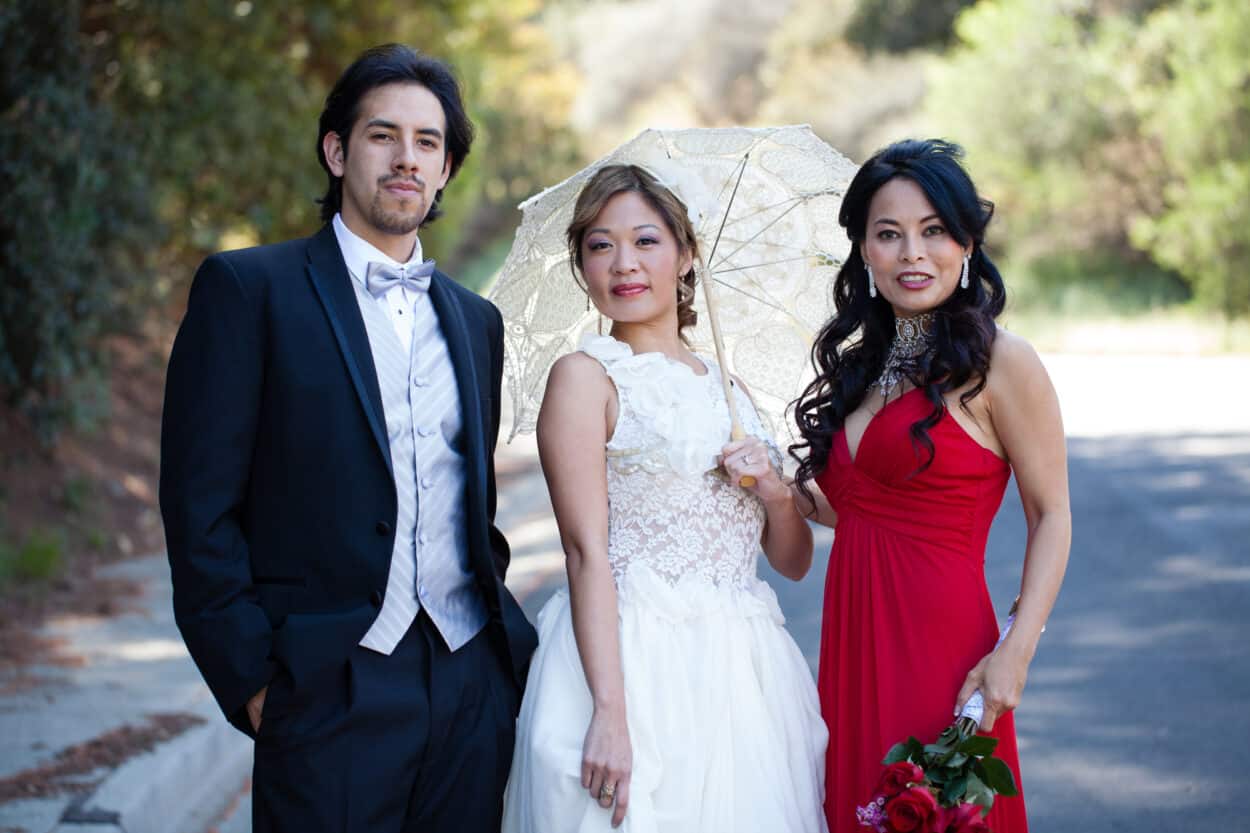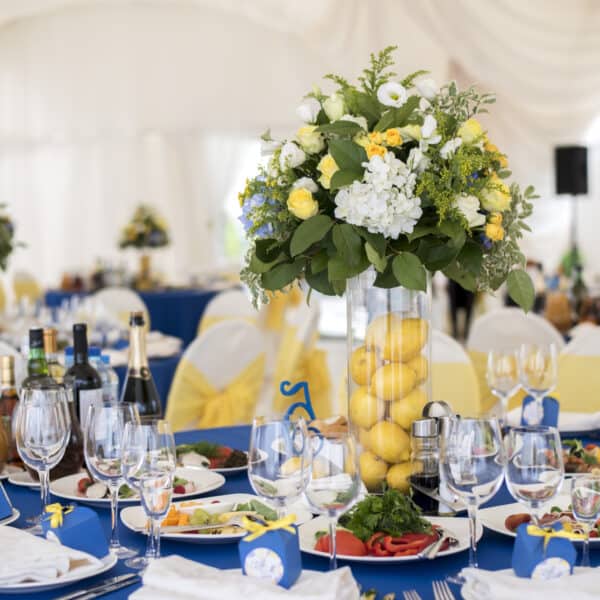Imagine stepping with me into the warm, colorful, and soulful world of Filipino weddings. It’s an enchanting realm swirling with deeply-rooted traditions, captivating rituals, and an undeniable community spirit; each aspect beautifully knitted together to weave not just a ceremony, but a vibrant cultural tapestry.
It’s a unique blend of Filipino family values, Spanish influences, church ceremonies, and scrumptious feasts – all combined to create an unforgettable matrimony that harmoniously binds two souls…and their families too!
Let’s wander together along this path, where the engagement kickstarts with ‘Pamamanhikan’, the endearing formal proposal involving both families.
From announcing marriages using the charming custom of ‘Pa-alam’ to communal wedding preparations sparked by the spirit of ‘Bayanihan’, every moment is an exciting chapter in this love-filled narrative.
Ready to witness rituals seeped in symbolism? The ‘Yugal’ cord and veil enchantment or the showering of prosperity through the ‘Arras’ coin ceremony will leave you spellbound. Don’t miss out on the delectable ‘Kalamay’ rice cakes and the breezy Money Dance! And there’s more – regional traditions too!
Onwards we venture then, into this splendid journey that offers a beautiful glimpse into the heart of Filipino culture – revealing its rich history, unyielding unity and endless celebrations of love. Let’s unfold this magical story together!
A Glimpse into Filipino Wedding Proposals: Pamamanhikan
Imagine diving into a beautiful sea teeming with shimmering creatures, except these are not marine dwellers; they represent fascinating cultural rituals! Let’s embark on this exploration with something known as ‘Pamamanhikan’ – a vital part of Filipino wedding proposals.
Here’s where Romeo meets Juliet’s family…not under the balcony, but over a dining table, merging the charm of romance with a dash of formal negotiations!
A prelude to the great commitment, ‘Pamamanhikan’ is not just about your dreamboat slipping that mighty ring on your finger. It’s more about two families coming together for the first time, sowing the seeds for a merger of clans!
This tradition underscores that a Filipino wedding isn’t merely about two people tying the knot; it’s more like an intimate family union.
So, future brides and grooms, take note! Before you lose yourself in selecting invitations or crafting Pinterest-worthy centerpiece ideas, remember one thing: family is everything. Ensure your families click and connect during ‘Pamamanhikan’, laying a solid familial foundation for your upcoming nuptials!
TL;DR: ‘Pamamanhikan’ is about the couple’s families meeting and negotiating over an upscale meal – symbolizing that weddings in Filipino culture are a union of two clans as much as they are between two individuals.
Wedding Announcements and the Custom of Pa-alam
Pop the champagne because you’re engaged! Just as you’re about to take a dive into the cascading waterfall of wedding preparations, you stumble upon something uniquely Filipino – ‘Pa-alam’.
Think carrying out traditional house-to-house announcements on horseback, except, well, we don’t need horses for that now!
Brimming with warmth and kinship, ‘Pa-alam’ essentially involves visiting your family and friends to personally hand them the invitation while announcing your wedding. In this digital era, where an impersonal text or email could suffice, ‘Pa-alam’ exceeds the typical norm.
It not only values human connections but also strengthens communal bonds.
And hey, here’s an insider’s tip: don’t just deliver invitations. Ask some important community members to be your wedding sponsors during these visits – essentially making them a part of your love story!
So, pop in at those homes and get announcing your happy news. Let drum rolls echo in every heart that reveres you, cherishes you, and is now going to become a beautiful part of your shared joyous journey!
TL;DR: The custom of ‘Pa-alam’ involves couples personally visiting folks near and dear (and maybe prominent folks too), delivering their wedding invitations – emphasizing human connections in weddings!
Wedding Preparations and The Spirit of Bayanihan
Early sunrise, the warmth of loved ones bustling around, laughter spilling over steaming cups of coffee – welcome to the magical world of wedding preparations guided by ‘Bayanihan’.
If you think ‘weddings’ and your mind races to towering bills, stress-inducing guest lists, amidst a whirlwind of chaos – stand corrected! In Filipino culture, we do it differently.
Imagine your close-knit circle chipping in – Susana preparing her famous stew for the reception, Billy arranging the chairs and tables – everyone is on board! This heartwarming communal support, known as ‘Bayanihan’, diffuses the stress and leaves plenty of room for collective joy.
Here’s what you can do: draw up the list of tasks, from decoration to dishes. Now, let ‘Bayanihan’ take over. Involve your friends and family who would love to contribute their time or talent as part of your wedding preparations.
So gear up, lovely people! Feel the power of unity as loved ones congregate, cook together and elaborate on decorations – turning prior nightmare-ish tasks into cherishable communal memories.
TL;DR: Embrace ‘Bayanihan’, the Filipino tradition involving communal support during wedding preparations. Transform daunting wedding jobs into shared moments brimming with love and collaborative spirit.
Parental Blessings: A Symbol of Respect and Approval
Let’s time travel back to our childhood when our parents beamed with joy at every milestone – a first step taken, a first word spoken, even the first tooth lost! Now, you’re stepping into a new chapter of life, and guess what? Their blessings are an absolute prerequisite!
Filipino weddings poignantly carry this emotion forward through parental blessings – a solemn moment that resonates through the wedding halls, radiating reverence and respect.
So take a pause – yes, between bustling flower arrangements and harmonizing seat plans – and imbibe the essence of this ritual.
As for how it’s done? Well, charm your way into everyone’s hearts by either Kissing the parents’ hands or touching your forehead to the back of their hands. Bask under their smiles that seal their approval and bathe you in epitomized respect.
Yoohoo all brides and grooms out there! Cushion your dream day with the warm glow of your parents’ smiles and heartfelt blessings – it’s the ultimate stamp of approval and respect.
TL;DR: Filipino weddings involve seeking parental blessings – a beautiful ritual that allows couples to express their respect for elders and gain their valuable approval for their union.
The Cord, Veil, and Coins: Symbolic Rituals in Filipino Weddings
Hold your breath as we dive deeper into the pool of Filipino wedding rituals. Weaving together symbolic threads of unity, protection, and prosperity – welcome to the intricate dance of the Cord, Veil, and Coins at Filipino weddings!
Ever wondered how walking down the aisle under a silken cord or an oversized rosary would feel? The ‘Yugal’, or the ritual involving a veil and cord spells enchantment. As beautifully elemental as it sounds, this unique tradition speaks volumes about unity and protection in marriage.
Meanwhile, let’s jingle some coins! Yes, you got it right! The groom presenting ‘arras,’ or thirteen gold coins to his to-be wife is not just a sweet token of love but signifies his commitment towards their joint prosperity.
Couples-to-be! Remember to include these symbolic rituals in your nuptial playbook. Add flavor to your vows by evoking timeless customs that seamlessly string together emblematic moments of unity, protection, and prosperity!
TL;DR: In Filipino weddings, the ‘Yugal’ ritual using a veil and cord symbolizes marital unity and protection while the ‘arras’ ceremony echoes commitment towards joint prosperity using thirteen gold coins. Soak into this triad of beautifully symbolic traditions!
Bridging Two Families: Unity Candle Lighting
Ready for another heartwarming episode on our journey through Filipino weddings? This time, we’re igniting flames of unity! No tall torches or fancy fireworks – all you need is a unity candle.
When two distinct families decide to blend as one, they do it with elegance, warmth, and a whole lot of symbolism! The enchanting ceremony in the spotlight? The unity candle lighting. It’s more than just flickering flames – it symbolizes two singular lives uniting to ignite a brighter, shared future.
As you tread the path of love, let this ritual be your milestone. Light that unity candle and let it carry the beacon of a new familial bond through your wedding halls!
Remember, its soft glow is not just about striking chords between two parties but signifies the slow and steady melting of boundaries into a single family.
TL;DR: The lighting of a unity candle in Filipino weddings represents the joining not just of two people, but two families into one – creating an illuminating symbol of newly forged familial bonds.
Rice Cakes and Wedding Feasts: Sharing Prosperity and Unity
Are you ready for nibbles of sticky ecstasy? Welcome to the sweet tradition of serving ‘Kalamay,’ or rice cakes, at Filipino weddings!
This is not just an ethnic delicacy passed down through generations but a symbolic representation of unity and prosperity.
These delightful treats bear the promise of your love, symbolizing the couple sticking together through life’s joyous highs and challenging lows.
So let’s make room for some rice cake magic amidst the crystal glasses and floral chandeliers at your wedding feast!
But wait, this gastronomic journey at Filipino weddings doesn’t end here. In a heartening show of respect, couples also share their first slice of wedding cake with parents and elders. As sugary bites melt in mouths, an undying bond unites hearts.
So all you lovebirds out there tying the knot, add this tasty tradition to your menu. Let your reception fill up with delighted gasps, satisfied smiles, and permeate an air of shared prosperity where throwing rice isn’t just celebratory fun but also a bounty of good blessings!
TL;DR: Delightful ‘kalamay’ or rice cakes served at Filipino weddings exemplify unity and prosperity, as does sharing the first slice of wedding cake with elders. It’s more than just a feast – it’s a deliciously symbolic celebration of shared joys and respect!
Fundraising and Entertainment: The Filipino Money Dance
Who says fundraisers can’t be fun? Blow up those balloons, tune the music, let’s groove to fundraising! Welcome to one of the most jovial traditions at a Filipino wedding – the Money Dance!
This fundraiser-cum-celebration ticks all boxes – entertainment, interaction, and a pretty neat trick to start your marital life on sound financial footing. As you sway together on the dance floor, your guests pin money on your outfits. It’s literal dancing for dollars!
What’s more? This lively tradition offers an amazing chance to interact with your guests. Make it interactive and fun. Toss in some upbeat music, flare up your moves; maybe organize a quick dance-off if you’re feeling adventurous!
So while you’re busy jotting down your wedding checklist, make sure “Money Dance” is right there at the top. Let’s mix finances with fun, shake a leg or two and watch how this merry ritual not only lightens your wedding costs but also heightens the entertainment quotient!
TL;DR: The famous “Money Dance” in Filipino weddings serves as both a source of entertainment and a unique fundraiser for couples – offering them a fun and interactive moment with guests while buffering their nuptial finances!
Unique Cultural Performances at Filipino Weddings
Awed by the rhythm of clinking coins at the Money Dance? Well, hold your cheers because our cultural charade doesn’t end there! Filipino weddings often showcase delightful cultural performances, with newlyweds stealing the spotlight!
What if we told you that weddings can be your stage, a platform to celebrate your love with a hint of ancestral glory? After all, who wouldn’t love a swirl or two in stunning traditional attires?
These vivacious performances are not just about exhibiting grace and rhythm though; they’re about showcasing the rich tapestry of heritage that you carry. Your own tale of love entwined with beautifully choreographed moves that stem from historic traditions – sounds captivating, doesn’t it?
Think about it. Amidst claps and cheers, as you dance your way to commemorate your union, you’re providing entertaining cultural exhibitions for your guests to enjoy, subtly knitting fascinating memories into the mosaic of your big day!
TL;DR: Lacing traditional performances into wedding celebrations endows Filipino weddings with unique charm and entertainment. Dress up in traditional finery and dance away to create an enchanting spectacle that’ll leave everyone breathless!
Sacred Tenets and Influences: Pre-colonial and Muslim Filipino Weddings
Let’s dive into a riveting chapter of our voyage through Filipino wedding rituals – one where the past reverberates in the present. Brace yourself for a fascinating fusion of cultural influences creating pre-colonial and Muslim Filipino wedding traditions!
Don’t these terms ‘kalilang’, ‘Nikah’, ‘Walima’ sound like mystic murmurs from the ancient world? Well, they are! ‘Kalilang’ is a captivating wedding tradition from Bangsamoro that predates Islam and shares uncanny resemblances with customs prevalent in Southeast Asia, China, and the Indian subcontinent.
Then we have ‘Nikah’, the enchanting marital contract ceremony, followed by the vibrant post-marriage reception, ‘Walima.’ These rituals echo the compelling cadence of ethnical influences scripted into today’s Filipino Muslim weddings.
And there’s more! You can even spot buoyant Hindu footprints in customary garlands and veiling during these ceremonial celebrations. A breathtaking blending of cultures, individualities, religions – all culminating into a single tag named love.
TL;DR: Pre-colonial and Muslim Filipino weddings showcase an intriguing blend of regional and ethnical influences, embroidering marvelous motifs like ‘kalilang’, ‘Nikah’, and ‘Walima’ into their ritualistic fabric.
Frequently Asked Questions
1. What is ‘Pamamanhikan’ in Filipino weddings?
It’s such a charming custom! Pamamanhikan is a formality observed in Filipino nuptial traditions where families of the couple first meet. The dialogue even culminates into an official wedding proposal, marking the beginning of a beautiful journey.
2. What’s unique about Filipino weddings and inviting guests?
Oh, they celebrate it grandly! ‘Pa-alam’, that’s what they call it. Couples personally pay visits to their invitees’ homes, delivering wedding invitations and making important announcements. It’s warmth carried in pretty paper cards!
3. I’ve heard something about ‘Bayanihan’ in Filipino wedding preparations. Can you elaborate?
Absolutely! Bayanihan is an ingrained societal approach in Philippines, embodying communal support. During wedding preparations, everyone pitches in – be it setting up the venue or cooking up a feast.
4. Is there some sort of parental blessing ritual at Filipino weddings?
Yes, indeed. Parental blessings play an integral role symbolizing respect for elders in Filipino weddings. Couples may touch their foreheads to the back of their parents’ hands or even kiss their parents’ hands asking for blessings and giving respect.
5. ‘Yugal’ and ‘arras’ seem intriguing! Could you explain?
Sure stranger! The ‘yugal’ refers to the cord and veil ceremony, symbolizing unity and protection between couples. ‘Arras’, on the other hand, is where the groom gifts 13 gold coins to his bride-to-be, representing his contribution to joint prosperity.
6. What’s with the whole unity candle lighting ceremony?
That’s one soulful tradition! Lighting a unity candle represents not just two souls uniting as one, but also two families fusing into a singular unit of warmth, love, and support.
7. Why are rice cakes significant at Filipino weddings?
Rice is sacred in Filipino culture. Serving ‘Kalamay’, or rice cakes at weddings is symbolic of the couple sticking together in their new life. Talk about edible symbolism!
8. Can you tell me more about the Filipino Money Dance?
It’s a wonderful tradition! In this fun-filled ritual, guests pin money onto the dancing couple, serving as a way for couples to start on sound financial footing while offering entertainment galore.
9. I’ve heard about dance performances at Filipino weddings. What’s that about?
How exciting! Newlyweds often showcase traditional dances at their wedding, providing a cultural treat for guests to enjoy. It’s more like a live tour through historic trail of dance steps!
10. Do Filipino Muslim weddings have different traditions?
Good question! They certainly do, with regional influences marking ceremonies like marital contract ‘Nikah’ and post-marriage reception ‘Walima’. Some traditions even predate Islam and resemble customs from Southeast Asia, China or the Indian subcontinent.
Wrapping It Up
And that, my delightful readers, is a quick but sincere dip into the ocean of Filipino wedding traditions! Whirlwinds of unity, heartstrings of familial bonds, and joyous dances that even raise funds – Filipino weddings aren’t just nuptials; they’re unique cultural carnivals. They interweave the past with present, religion with romance, delicacies with traditions. A fascinating fusion indeed!
So whether you’re planning a traditional Filipino wedding or just intrigued by global wedding customs, remember this stroll through tales of unity candles, ‘Pamamanhikan’, ‘arras’, and more. After all, each marriage is a story hinted in rituals. Perhaps it’s time to weave yours in these shared traditions.
Remember, regardless of culture or customs playing cupid in your love story, one rule stands undaunted – let love lead. Happy Wedding Planning!
- Say ‘I Do’ with a Woof: 10 Adorable Golden Retriever Wedding Cake Topper Ideas! - December 10, 2024
- Bridal Set Vs Engagement Ring: An In-depth Guide to Help You Decide - October 14, 2023
- Unveiling the Heart of Filipino Weddings: Fascinating Traditions and Rituals - September 25, 2023




Leave a Comment